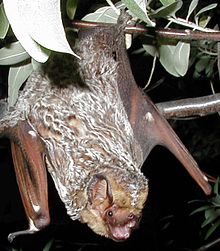Hoary bat
| Hoary bat | |
|---|---|

| |
| Scientific classification | |
| Domain: | Eukaryota |
| Kingdom: | Animalia |
| Phylum: | Chordata |
| Class: | Mammalia |
| Order: | Chiroptera |
| Family: | Vespertilionidae |
| Genus: | Aeorestes |
| Species: | A. cinereus
|
| Binomial name | |
| Aeorestes cinereus (Beauvois, 1796)
| |

| |
| Distribution of the hoary bat (2008) | |
The hoary bat (Aeorestes cinereus) is a type of bat in the family Vespertilionidae. It is found throughout most of North America and much of South America. It is also found in the Galápagos Islands and Hawaii.
Description[change | change source]
The hoary bat is 13 to 14.5 cm (5.1 to 5.7 in) long. It has a wingspan of 40 cm (15.5 in). It weighs 26 g (0.92 oz). Its fur is dense and dark brown, with white tips to the hairs.[2] The body is covered in fur except for the undersides of the wings. Males and females are sexually dimorphic in body mass.[3]
Behaviour[change | change source]
It normally roosts alone on trees. But sometimes, it has been seen in caves with other bats. It prefers woodland, mainly coniferous forests, but hunts over open areas or lakes. It hunts alone and it mainly eats moths. The bats can travel 39 km (24 mi) while foraging.[2] In the winter, they live in Central America and the southwestern United States. In the spring and summer, they live in the United States and Canada.[4]
Reproduction[change | change source]
The reproductive cycle of the hoary bat is not yet fully understood. But, it is thought that they mate in August. It is also thought that they give birth in June of the following year. It is thought that the gestation period is only 40 days. It gives birth to one pup, or sometimes twins. The young ones stay with the mother for a month before leaving.
References[change | change source]
- ↑ Gonzalez, E.; Barquez, R.; Arroyo-Cabrales, J. (2016). "Lasiurus cinereus". The IUCN Red List of Threatened Species. 2016: e.T11345A22120305.
- ↑ 2.0 2.1 "Hoary bat videos, photos and facts - Lasiurus cinereus | ARKive". 2016-05-05. Archived from the original on 2016-05-05. Retrieved 2020-10-27.
- ↑ Shump, Karl A.; Shump, Ann U. (1982-06-18). "Lasiurus borealis". Mammalian Species (183): 1–6. doi:10.2307/3503843. JSTOR 3503843. S2CID 253901188.
- ↑ Cryan, P. M. (2003-10-01). "Sex differences in the thermoregulation and evaporative water loss of a heterothermic bat, Lasiurus cinereus, during its spring migration". Journal of Experimental Biology. 206 (19): 3381–3390. doi:10.1242/jeb.00574. ISSN 0022-0949. PMID 12939370. S2CID 24661456.

